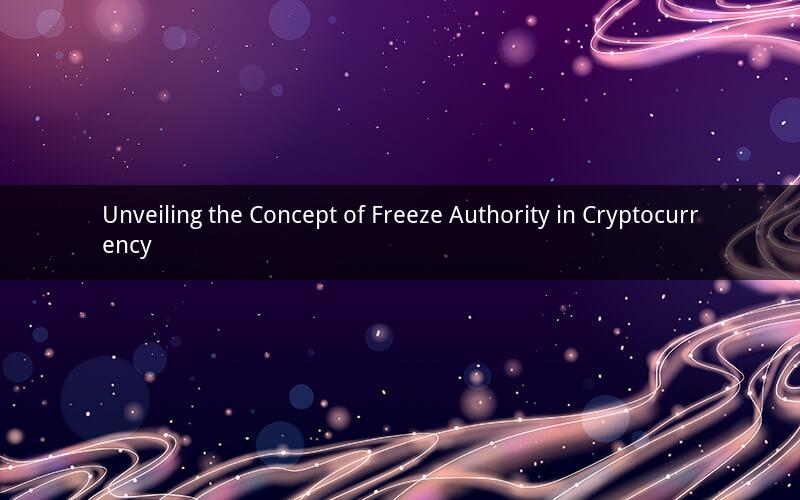
Introduction:
In the world of cryptocurrency, freeze authority has emerged as a crucial aspect of ensuring security and maintaining the integrity of digital assets. This article delves into the definition, significance, and implications of freeze authority in the crypto domain.
Section 1: Understanding Freeze Authority
1.1 Definition:
Freeze authority refers to the power granted to certain entities or individuals within a cryptocurrency ecosystem to temporarily halt transactions or freeze assets on the blockchain. It serves as a mechanism to prevent fraudulent activities, money laundering, and other malicious acts.
1.2 Importance:
1.2.1 Combating Fraud:
Freeze authority allows blockchain networks to address fraudulent activities promptly. By halting transactions, it prevents the transfer of funds to malicious actors, thereby safeguarding the integrity of the network.
1.2.2 Preventing Money Laundering:
Freeze authority plays a vital role in combating money laundering by enabling authorities to freeze assets linked to illegal activities. This helps in tracing the origin of funds and preventing their misuse.
1.2.3 Ensuring User Security:
Freeze authority provides an additional layer of security for users, as it allows for the quick resolution of disputes and the retrieval of stolen funds.
Section 2: How Freeze Authority Works
2.1 Triggering Freeze Authority:
Freeze authority can be triggered by various entities, including exchanges, wallet providers, or even regulatory bodies. These entities have the ability to initiate a freeze request based on specific criteria or when suspicious activities are detected.
2.2 Freeze Process:
When a freeze request is initiated, the freeze authority is activated, and the affected assets are temporarily locked on the blockchain. This prevents any further transactions involving those assets until the freeze is lifted.
2.3 Verification and Resolution:
Once the freeze is activated, the relevant parties, such as law enforcement or regulatory bodies, investigate the situation. If the freeze is deemed necessary, it remains in effect until the issue is resolved. Once resolved, the freeze is lifted, and the assets can be transferred or released.
Section 3: Implications of Freeze Authority
3.1 Privacy Concerns:
One of the main criticisms of freeze authority is the potential threat to privacy. Critics argue that the power to freeze assets can be misused, leading to unwarranted surveillance and violations of individual privacy rights.
3.2 Centralization Risks:
Freeze authority can lead to centralization within the cryptocurrency ecosystem. If a few entities or individuals hold significant control over the freeze authority, it can create a concentration of power and potentially undermine the decentralized nature of blockchain technology.
3.3 Regulatory Challenges:
The implementation of freeze authority raises regulatory challenges. Different jurisdictions have varying laws and regulations regarding the freezing of assets, which can lead to inconsistencies and conflicts.
3.4 User Trust:
The presence of freeze authority can impact user trust in the cryptocurrency ecosystem. Users may be concerned about the potential misuse of power and the lack of transparency surrounding the freeze process.
Section 4: Case Studies
4.1 The Mt. Gox Scandal:
One of the most notable cases involving freeze authority is the Mt. Gox scandal. In 2014, the Bitcoin exchange suffered a massive hack, resulting in the loss of hundreds of thousands of Bitcoin. freeze authority was used to halt withdrawals, allowing the exchange to investigate the breach and prevent further losses.
4.2 The Tether Freeze:
In 2019, the stablecoin Tether faced allegations of fraudulent activities. freeze authority was utilized to freeze the Tether tokens, enabling investigations into the allegations and ensuring the integrity of the currency.
Section 5: Future Prospects
5.1 Enhanced Transparency:
To address privacy concerns and enhance user trust, the future of freeze authority may involve greater transparency. Blockchain networks can implement features that allow users to track freeze requests and their outcomes, ensuring accountability and transparency.
5.2 Regulatory Framework:
Developing a comprehensive regulatory framework for freeze authority is crucial. This framework should address the risks of misuse, centralization, and privacy concerns while ensuring effective law enforcement and regulatory oversight.
5.3 Technological Advancements:
Advancements in blockchain technology can contribute to the evolution of freeze authority. Features like smart contracts and decentralized governance can provide more efficient and transparent mechanisms for managing freeze requests.
Questions and Answers:
1. What is the primary purpose of freeze authority in cryptocurrency?
Answer: The primary purpose of freeze authority is to prevent fraudulent activities, money laundering, and ensure user security by temporarily halting transactions or freezing assets on the blockchain.
2. Can freeze authority be used to freeze any asset on the blockchain?
Answer: No, freeze authority can only be used to freeze specific assets that are under the control of entities or individuals with the authority to initiate a freeze request.
3. How long can an asset remain frozen under freeze authority?
Answer: The duration of a freeze depends on the specific circumstances and the resolution process. It can vary from a few hours to several days or even weeks, depending on the complexity of the situation.
4. Can freeze authority be滥用?
Answer: While there is a risk of misuse, efforts are being made to address this concern. Blockchain networks and regulatory bodies are working towards establishing transparent and accountable mechanisms to ensure the responsible use of freeze authority.
5. What is the role of users in the freeze authority process?
Answer: Users can play a role by reporting suspicious activities or concerns. They can also track freeze requests and their outcomes to ensure transparency and accountability within the cryptocurrency ecosystem.